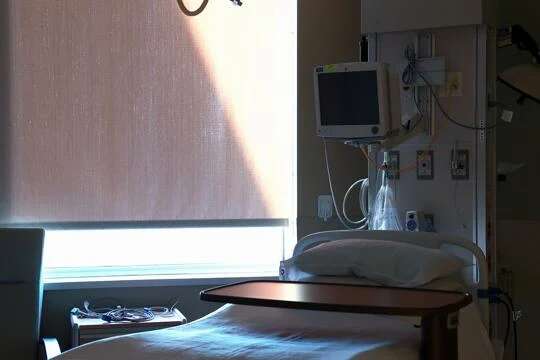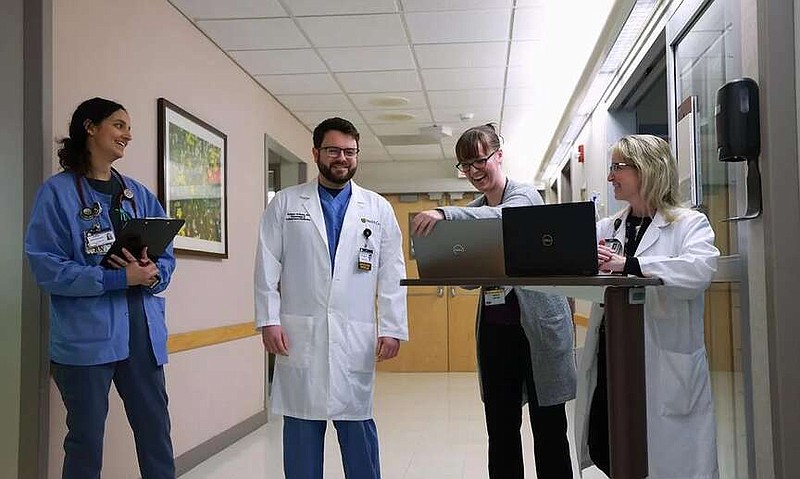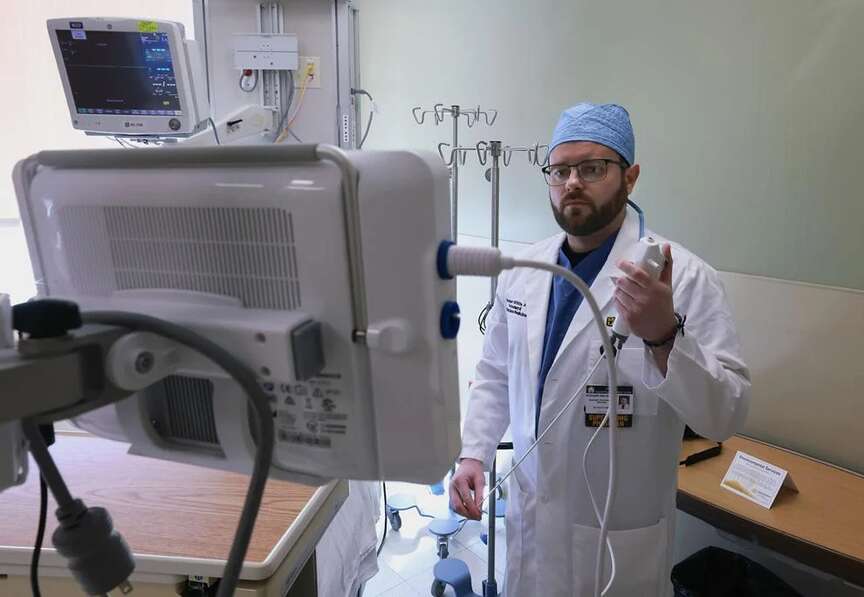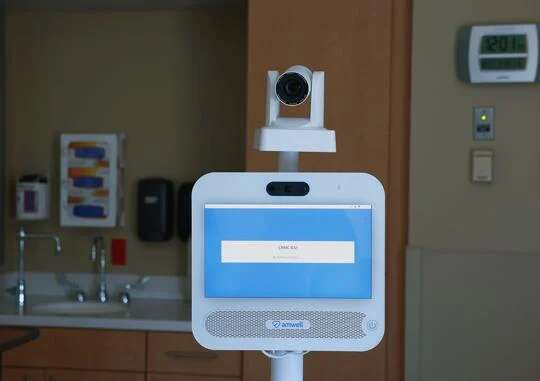Capital Region Medical Center was struggling.
The COVID-19 pandemic took a heavy toll on the Jefferson City hospital's staff and revenues. Patients were staying home rather than coming to in-person clinic appointments. Nurses were leaving.
Then came a disruptive and challenging conversion to a new electronic records management system.
And then, the final blow: A cyber attack that shut down many of the hospital's operating systems, which took weeks to fully recover from.
The stage was set for a rescue.
Last year, MU Health Care, CRMC's long-term affiliate, agreed to take over the 73-year-old hospital. On June 8, 2023, MU Health Care and CRMC signed a letter of intent to fully integrate their systems. Later that month, CRMC entered into an agreement with the University of Missouri-Columbia Medical Alliance, making the Medical Alliance the sole controlling member of CRMC and giving it full power to appoint and remove members of CRMC's board of directors. Capital Region became the seventh hospital in the MU Health Care system.
On Jan. 1, the two parties announced the integration was complete.
The transition has been bumpy and it may be three years before the Jefferson City hospital is no longer operating in the red. But CRMC officials and MU leaders say they're starting to see the fruits of the takeover.
This investment benefits both Columbia and Jefferson City through increased levels of specialty care for CRMC, officials said. It has enabled MU Health Care to better manage capacity across all types of care and facilities, ensuring patients have access to the appropriate level of care as needed. It has kept open the doors of Jefferson City's largest hospital, whose 114 beds draw patients from eight counties and employs 1,422 people, making it the capital city's fourth-largest employer. The hospital was able to retain nearly all its providers, said Denny Hamilton, CRMC's chief operating officer.
"Columbia has had the challenge, historically, of people in need of care throughout Missouri trying to get transferred to a bed here, and we've had difficulty in being able to meet that demand," said Ric Ransom, chief executive officer of MU Health Care. "So with the new capacity that we've got available in Jeff City ... being able to have those patients from those eight counties that can be appropriately cared for in Jefferson City directed there instead of Columbia and increasing those patient volumes is the second main portion of what we're going to do to try and improve financial performance."
Officials and providers point to other advantages as well, from shared expertise to the possibility of CRMC patients participating in clinical trials for new treatments in the coming months.
But one of the biggest advantages is even simpler: Jefferson City patients can continue to get quality care close to home.
Dr. Rodger Wilhite is a critical care medicine and pulmonary disease doctor from MU Health Care assigned to work in CRMC's critical care unit. On day three of his first seven-day shift, he had the rewarding experience of being thanked by the family of a patient. Before the merger, the patient would have been transferred to Columbia for more intensive care. Such a move would have made traveling for visits, especially at night, much harder for the patient's older spouse. Instead, the couple was able to drive down the street from their home and visit all day. The couple thanked him for allowing them to stay close to home and be by their loved one's side as much as possible.
"To feel that appreciation, really get that sense of welcoming, is by far probably the highlight of my experience here," Wilhite said.
Before the integration
MU Health Care and CRMC have an affiliation that dates back 25 years. The two have partnered on joint clinics like Capital Region's ear, nose and throat clinic and Missouri Orthopedic Institute. In emergency medicine, MU Health Care clinicians have been the exclusive providers of emergency services and have helped staff the emergency department at CRMC for several years. The two entities have also worked together to negotiate payer contracting -- how health care providers and health plan providers agree on terms and conditions for medical services, coverage and payment.
To combat the expected unease from doctors about the changing workplace environment and to retain the majority of providers, Dr. Randall Haight, CRMC's chief medical officer, led the physician and practitioner migration team. They assured the staff that they would maintain their current salaries. Additionally, the team kept open lines of communication through emails and regularly scheduled meetings with both CRMC and MU Health Care.
To alleviate concerns from doctors about possibly becoming more of a teaching hospital, Haight developed and now leads the Department of Community Practice, which allows doctors to maintain their clinical focus.
"By having and developing the Department of Community Practice, we're able to do what we love, which is seeing patients," Haight said.
Haight also stressed the importance of maintaining leadership to achieve a high retention rate.
Recent financial setbacks made the need for help from MU more acute. CRMC entered the COVID pandemic with already slim margins. During the pandemic, the hospital saw a drop in clinic and hospital visits and lost several nurses, further increasing the financial strain. Additionally, the adoption of the Cerner electronic medical records system presented challenges. This, along with a cyber attack that blocked internal communication and access to patient electronic medical charts, set the scene for the integration with MU Health Care.
"Coming out on the other side of the pandemic, we definitely were facing challenges being a smaller community hospital and were really needing the resources of MU more and more," said Dr. Susan Voss, a pediatrician at CRMC for more than 20 years.
CRMC failed to meet its debt-to-service ratio for 2022 and 2023 and reported a net loss of $34 million in May 2023. According to MU Health Care's 2023 financial report, it made a $34 million cash grant to CRMC to pay for a bond from 2017 and a majority of its 2020 bond. CRMC had also taken out $28.6 million in bonds in 2021, which was paid off before the integration. MU is not currently liable for CRMC's debts.
The future of CRMC
MU Health Care entered into the agreement knowing it would take time to bring CRMC back to operating in the black. MU officials expect it will take another two to three years to reach that milestone.
To do that, MU Health Care plans to reduce expenses by utilizing discounts that come with purchasing supplies in larger volumes. MU Health Care also plans to use the clinical capacity of CRMC to ease the demand for beds in Columbia and in turn increase Capital Region's patient volume. Its eight-county coverage area overlaps with MU Health Care's 25-county coverage area, so officials hope to keep patients from CRMC's area in Jefferson City when they would have been transferred to Columbia for more specialized care in the past.
In order to accomplish this, MU Health Care has been focusing on increasing the specialized care CRMC is capable of providing in the areas of orthopedic care, spinal care, critical care and bariatric procedures. The hospital has plans for additional services in the future. In addition, CRMC patients can now take full advantage of MU Health Care's clinical trials for new and experimental treatments and research. This kind of cooperation is not new, but there now are fewer barriers for MU Health Care to increase its scale and involvement.
"There are all kinds of services that we're looking to bring closer to the community here in Jefferson City, with the intent that, when folks need care that they can actually stay here in Jefferson City at home and receive that care," Hamilton said.
"The big thing we're working on is to try and improve our quality of care and meet the high standards," Voss said. "MU has all the access to the latest research and they have the latest specialists working on stuff, so we're able to tap into that and hopefully provide that high quality of care here in Jefferson City, too."
The critical care unit: A learning environment
The critical care unit at CRMC was one of the first places to see major integration with staffing beginning Jan. 2. Currently, a team of 22 critical care doctors from MU with varying specialties help staff the unit in seven-day shifts. In the evenings, consultation and care are provided with the help of an Amwell robot that allows doctors to see and talk to patients and staff remotely.
Before, the critical care unit was staffed by hospitalists who had critical care training. These doctors would focus on their normal inpatient responsibilities as well as doing rounds in the critical care unit. The team of 22 will eventually be reduced to a smaller group who are a good fit and would like to stay at CRMC. Wilhite hopes to be one of those doctors.
"There's only so much you can really try to understand based off of labs and on the phone call with either the physician or nursing," Wilhite said about the Amwell robot. "So here we can get direct visualization of what's going on with the patient, what's happening with the ventilator, all of the alarms and waveforms on the machine."
This level of cooperation and assimilation has brought procedures to CRMC that are common in Columbia and has presented the opportunity for CRMC staff to learn about different procedures and approaches. For Wilhite, who specializes in pulmonary medicine, a bronchoscopy is a standard procedure where a doctor looks at air passages with a small camera. However, during his first days at CRMC, he found some nurses and respiratory therapists who had not seen one done in a long time and were eager to learn.
"I think that all of the nursing and respiratory therapists, now that we're providing services that we haven't had down here in a while, they're very eager to learn," Wilhite said. "There's still that continuation of teaching and discussion about certain modalities, equipment and procedures."
"We did this bronchoscopy procedure yesterday and there was a lot of students and everyone was just so excited to see it. (I) almost kind of felt like a celebrity; there's a whole kind of viewing gallery," Wilhite added. "These things we do daily get taken for granted. It's like, 'Oh, just another bronc.' But here, it's like, 'Oh, something's happening, let's all get there and try to learn from this.'"
The work of the Missouri News Network is written by Missouri School of Journalism students and editors for publication by Missouri Press Association member newspapers.
 Allie Santini/Missourian
Light reflects off a hospital bed in the critical care unit of the Capital Region Medical Center on Feb. 28 in Jefferson City. The integration between MU Health Care and Capital Regional Medical Center hopes to increase critical care capacity and treatment options in Cole County.
Allie Santini/Missourian
Light reflects off a hospital bed in the critical care unit of the Capital Region Medical Center on Feb. 28 in Jefferson City. The integration between MU Health Care and Capital Regional Medical Center hopes to increase critical care capacity and treatment options in Cole County.


